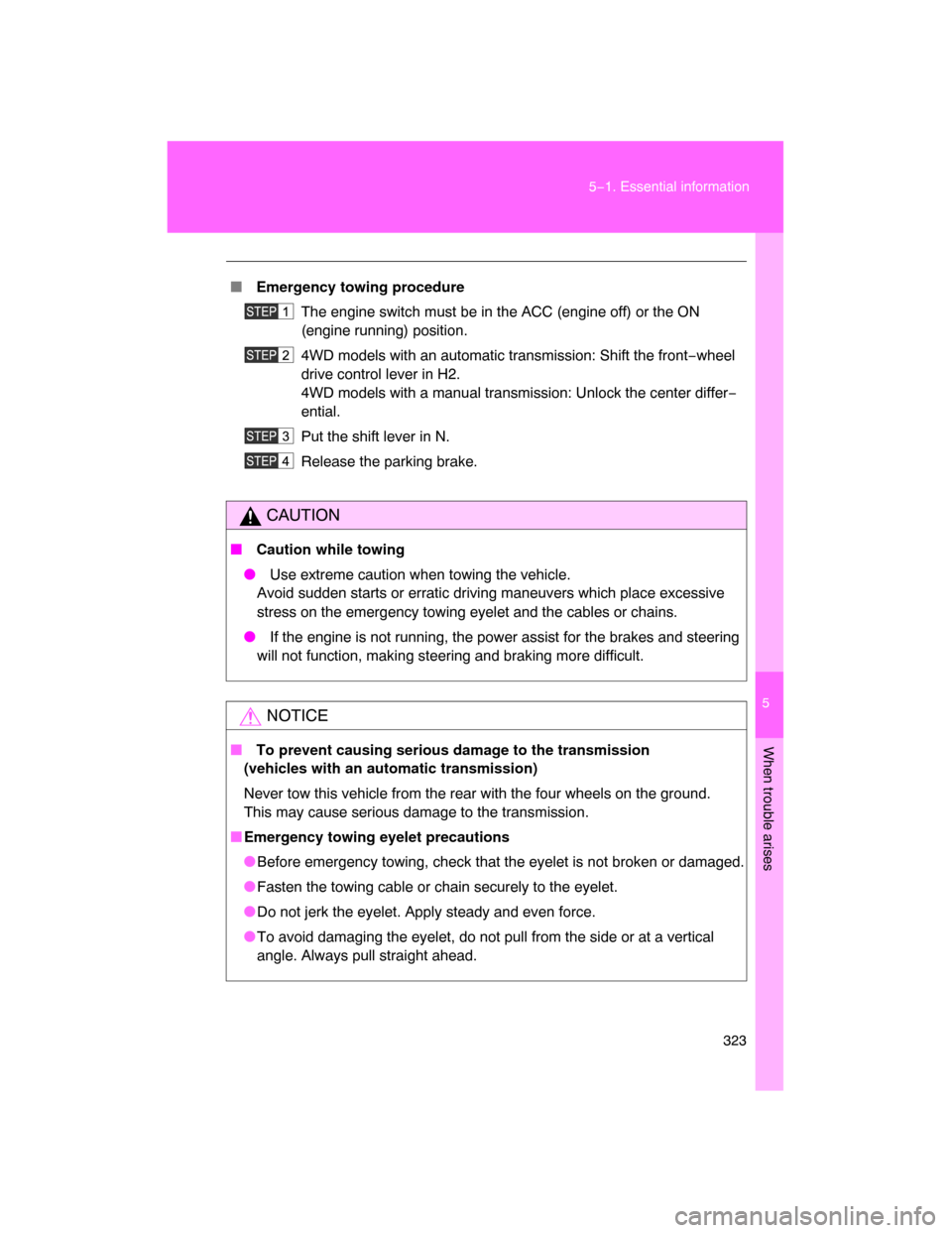Page 178 of 400

180 2−5. Driving information
� Always place wheel blocks under both the vehicle and the trailer
wheels when parking. Apply the parking brake firmly, and put the
transmission in P (automatic transmission) or in 1 or R (manual
transmission). Avoid parking on a slope, but if unavoidable, do so
only after performing the following:
Apply the brakes and keep them applied.
Have someone place wheel bloc
ks under both the vehicle and
trailer wheels.
When the wheel blocks are in place, release the brakes slowly
until the blocks absorb the load.
Apply the parking brake firmly.
Shift into 1 or R (manual transmission) or P (automatic trans−
mission) and turn off the engine.
� When restarting after parking on a slope:
With the transmission in P (automatic transmission) or the
clutch pedal (manual transmission) depressed, start the
engine. On vehicles with an au tomatic transmission, be sure
to keep the brake pedal pressed.
Shift into a forward gear. If reversing, shift into R.
Release the parking brake (also
brake pedal on vehicles with
an automatic transmission), and slowly pull or back away from
the wheel blocks. Stop and apply the brakes.
Have someone retrieve the blocks.
Page 262 of 400
266 4−2. Maintenance
Vehicle interior
Items Check points
Accelerator pedal�Moves smoothly (without uneven
pedal effort or catching)?
Automatic transmission “Park”
mechanism�Can the vehicle be hold securely
on an incline with the shift lever in
P?
Brake pedal�Moves smoothly?
�Does it have appropriate clear−
ance and correct amount of free
play?
Brakes�Not pull to one side when
applied?
�Loss of brake effectiveness?
�Spongy feeling brake pedal?
�Pedal almost touches floor?
Clutch pedal�Moves smoothly?
�Does it have correct amount of
free play?
Head restraints�Move smoothly and lock
securely?
Indicators/buzzers�Function properly?
Lights�Do all the lights come on?
�Headlights aimed correctly?
( P. 314)
Parking brake�Moves smoothly?
�Can hold the vehicle securely on
an incline?
Seat belts�Does the seat belt system oper−
ate smoothly?
�Are the belts undamaged?
Seats�Do the seat controls operate
properly?
Page 308 of 400

312 4−3. Do−it−yourself maintenance
7 ECU−IG 10 AAnti−lock brake system, vehicle sta−
bility control system, traction con−
trol system, active traction control
system, AUTO LSD system, multi−
port fuel injection system/sequen−
tial multiport fuel injection system,
cruise control system, back door
lock system, shift lock system, mul−
tiplex communication system
8 IG1 15 ATurn signal lights, air conditioning
system, charging system, clutch
start cancel switch, anti−lock brake
system, traction control system,
active traction control system, vehi−
cle stability control system, AUTO
LSD system, back−up lights, intui−
tive parking assist, rear differential
lock system, power outlet, acces−
sory meter, meter and gauge
9 STA 7.5 AStarting system, clutch start cancel
switch, power outlet
10 TAIL 10 ATail lights, license plate lights, park−
ing lights, instrument panel light
control, illuminations
11 A C C 7 . 5 AShift lock system, outside rear view
mirrors, audio system, power out−
let, clock, accessory meter, multi−
plex communication system
12 POWER 30 A Power windows
FuseAmpereCircuit
Page 318 of 400

5
When trouble arises
323 5−1. Essential information
� Emergency towing procedure
The engine switch must be in the ACC (engine off) or the ON
(engine running) position.
4WD models with an automatic transmission: Shift the front−wheel
drive control lever in H2.
4WD models with a manual transmission: Unlock the center differ−
ential.
Put the shift lever in N.
Release the parking brake.
CAUTION
� Caution while towing
� Use extreme caution when towing the vehicle.
Avoid sudden starts or erratic driving maneuvers which place excessive
stress on the emergency towing eyelet and the cables or chains.
� If the engine is not running, the power assist for the brakes and steering
will not function, making steering and braking more difficult.
NOTICE
� To prevent causing serious damage to the transmission
(vehicles with an automatic transmission)
Never tow this vehicle from the rear with the four wheels on the ground.
This may cause serious damage to the transmission.
�Emergency towing eyelet precautions
�Before emergency towing, check that the eyelet is not broken or damaged.
�Fasten the towing cable or chain securely to the eyelet.
�Do not jerk the eyelet. Apply steady and even force.
�
To avoid damaging the eyelet, do not pull from the side or at a vertical
angle. Always pull straight ahead.
Page 321 of 400
326 5−1. Essential information
Using a flat bed truck
If your Toyota is transported by a
flat bed truck, it should be tied
down at the locations shown in
the illustration.
If you use chains or cables to tie
down your vehicle, the angles
shaded in black must be 45 .
Do not overly tighten the tie
downs or the vehicle may be
damaged.
Apply the parking brake firmly.
Front
Page 326 of 400
5
When trouble arises
331
5−2. Steps to take in an emergency
If a war ning light tur ns on or a war ning buzzer sounds...
Stop the vehicle immediately. Continuing to drive the vehicle may be dangerous.
The following warning indicates a possible problem in the brake sys−
tem. Immediately stop the vehicle
in a safe place and contact your
Toyota dealer.
Warning lightWarning light/Details
Brake system warning light
�Low brake fluid
�Malfunction in the brake system
This light also comes on when the parking brake is
not released. If the light turns off after the parking
brake is fully released, the system is operating nor−
mally.
Calmly perform the following actions if any of the warning lights turn
on or flash. If a light turns on or flashes, but then turns off, this does
not necessarily indicate a malfunction in the system.
Page 335 of 400
340
5−2. Steps to take in an emergency
If you have a flat tire
Remove the flat tire and replace it with the spare provided.
� Before jacking up the vehicle
� Stop the vehicle on a hard, flat surface.
�Set the parking brake.
�
Shift the shift lever to P (automatic transmission) or R (manual
transmission).
� Stop the engine.
�Turn on the emergency flashers.
�
Location of the spare tire, jack and tools
Tool bag
Spare tire
Jack
Page 346 of 400
5
When trouble arises
351
5−2. Steps to take in an emergency
If the shift lever cannot be shifted from P
If the shift lever cannot be shifted with your foot on the brake, there
may be a problem with the shif
t lock system (a system to prevent
accidental operation of the shift lever). Have the vehicle inspected by
your Toyota dealer immediately.
The following steps may be used as an emergency measure to
ensure that the shift
lever can be shifted.
Set the parking brake.
Turn the engine switch to the ACC or ON position.
Depress the brake pedal.
Pry the cover up with a flat−
head screwdriver or equiva−
lent.
Press the shift lock override
button.
The shift lever can be shifted
while the button is pressed.